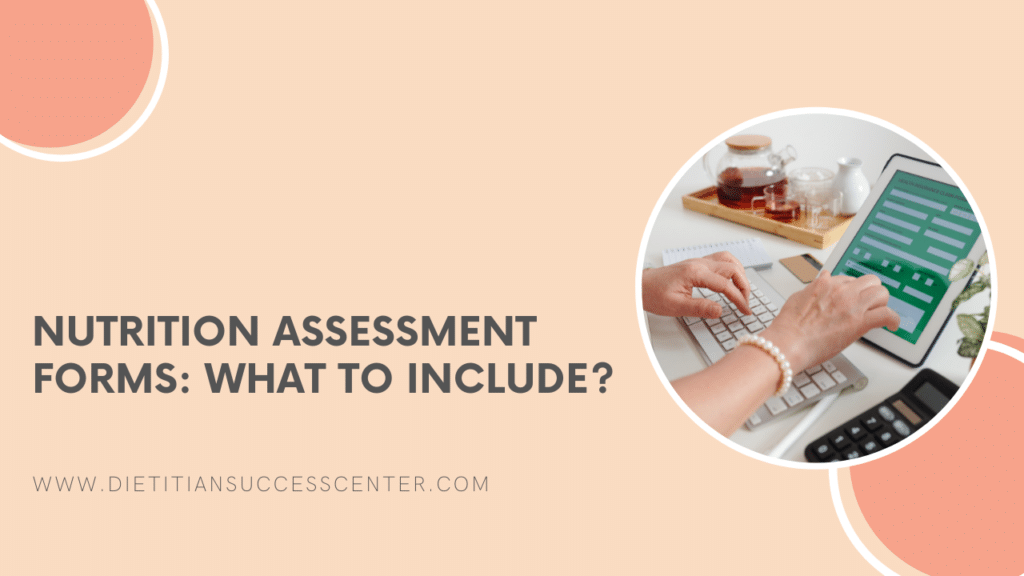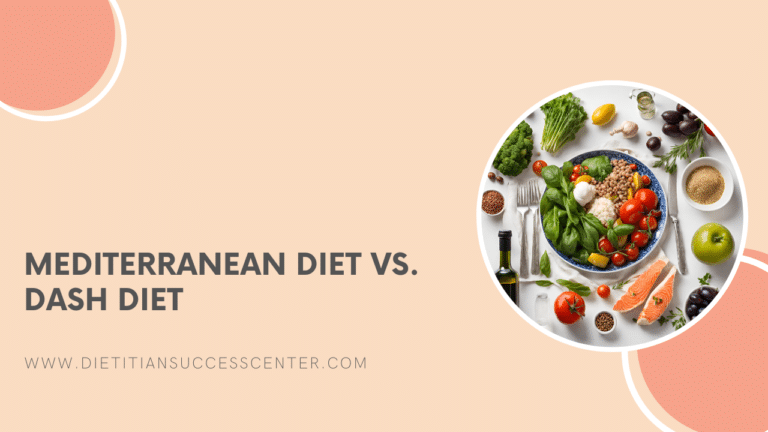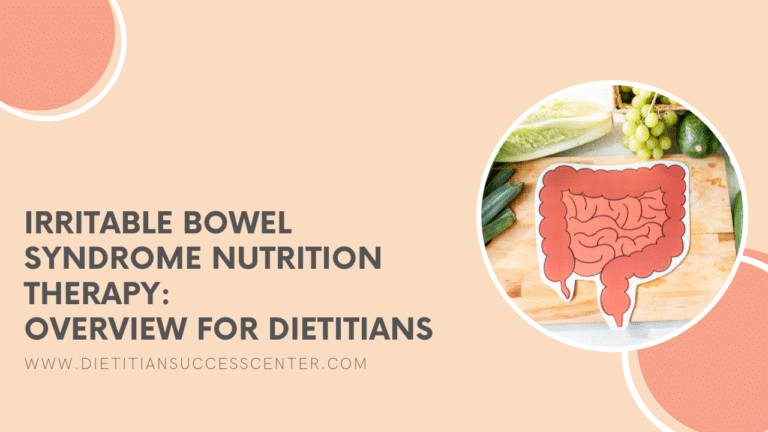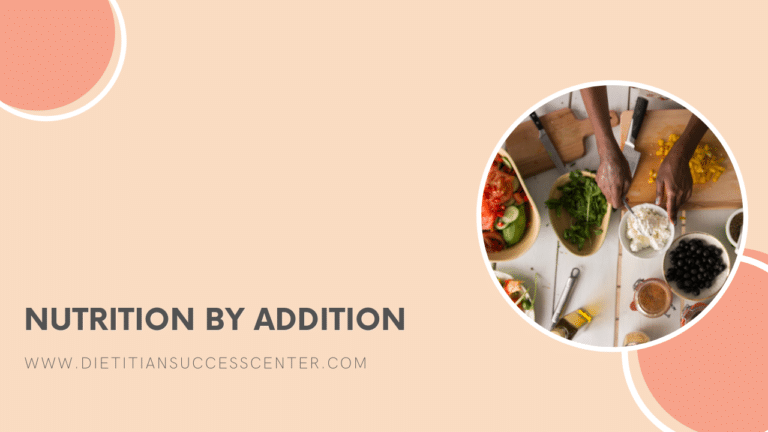

Written by Olivia Farrow, RD, MHSc
Reviewed by Maria Dellanina, RDN
In the realm of nutrition care, a well-structured nutrition assessment is key to understanding and addressing a client’s unique needs. In this blog post, we’ll delve into the intricacies of nutrition assessment forms; what nutrition assessment entails and what to include in effective intake forms and chart notes to simplify the process.
Understanding Nutrition Assessment
Nutrition assessment is the first part of the nutrition care process; the “A” in ADIME. At its core, nutrition assessment is a systematic methodology, encompassing the collection, classification, and synthesis of pertinent data (1). This process is not a one-time event, but rather an ongoing, dynamic journey that involves initial data collection, continual reassessment, and analysis of a client’s status in relation to accepted standards, recommendations, and goals (1).
Key Components of Nutrition Assessment:
The nutrition care process includes 9 categories of nutrition assessment data (1). Each of these categories should be included on nutrition assessment forms, however the examples of data collected will depend on the individual client and practice setting (1):
- Food/Nutrition-Related History: Delving into food and nutrient intake, administration, medication use, beliefs, attitudes, behavior, and more.
- Anthropometric Measurements: Considering body height, weight, frame, changes, and growth patterns.
- Biochemical Data, Medical Tests, and Procedures: Incorporating lab data, medical tests, and procedures.
- Physical Exam Findings: Evaluating findings from physical exams, interviews, or health records.
- Client History: Exploring personal, family, and social history.
- Assessment, Monitoring, and Evaluation Tools: Utilizing tools for health or disease status assessment.
- Etiology Category: Categorizing the type of nutrition diagnosis etiology.
- Comparative Standards: Establishing benchmarks for data comparison.
- Progress Evaluation: Assessing progress toward nutrition-related goals and resolution of nutrition diagnoses.
Where to Find Nutrition Assessment Data?
The nutrition assessment data in each of the 9 categories, can be sourced before interacting with the client, through intake forms, health records, or information from referring or team healthcare providers.
Data obtained before interacting with the client should always be confirmed during direct client interaction (or interactions with their substitute decision maker). During client interactions, additional data can be obtained directly from the client or based on observations during the session.
Your Nutrition Assessment Forms
Nutrition assessment forms can be broken down into different components, which will likely include:
-
- A data collection form; such as an initial intake form.
-
- A dietary intake form; a space for the client or practitioner to fill in food intake data.
-
- A chart note; the formal documentation space where the complete nutrition assessment will be outlined.
Having detailed intake form and chart note templates can help to support optimal nutrition assessment data collection.
DSC has collaborated with Practice Better to provide you with a FREE form template bundle including:
-
- Adult intake form
-
- Pediatric intake form
-
- Initial chart note template
-
- Follow-up chart note template
-
- 24-hour recall template
-
- 3-day food record template

Disclaimer: The form bundle was sponsored by Practice Better.
Crafting Your Nutrition Assessment Forms
The first part of your nutrition assessment forms is a space for gathering nutrition assessment data. This could be in the form of an intake form that the client fills out, a data collection form that you complete while interacting with the client and/or from the client’s data in their medical chart. To make your nutrition assessment simpler and more comprehensive, an intake or data collection nutrition assessment form might include:
- Personal Information: contact details, reason for consultation (referral or request), relevant demographic and lifestyle information.
- Medical History: Conditions, surgeries, medications, allergies, supplement use, cognitive function data.
- Nutrition-focused physical findings: Physical symptoms related to nutrition such as appetite, swallowing, skin integrity, gastrointestinal symptoms, subjective global assessment.
- Biochemical Data: Including pertinent lab results and medical tests.
- Dietary Habits: Detailed insights into food preferences, meal patterns, and special dietary requirements. This might include a 24-hour recall, 3-day food record, or food frequency questions.
- Lifestyle Factors: Understanding physical activity (type and quantity of movement, sedentary activities, occupational related activity, ability to perform physical movements), sleep, and stress levels.
- Anthropometric Measurements: Height, weight (and source of data), weight history, how often weight is obtained, and relevant indices.
- Social and Cultural Factors: Factors affecting access to food, behaviors around food, social network, culturally related requirements around food or nutrition.
- Nutrition Knowledge and Attitudes: Level or areas of nutrition knowledge and food/health literacy, attitudes, beliefs, and relationship with food, readiness for change.
- Goals and Expectations: Exploring the client’s health and nutrition goals.
Your assessment might also include a validated screening tool such as a malnutrition screening tool, either as part of your nutrition assessment forms or separately.
Utilizing Your Nutrition Assessment Data
After gathering all of the data you need for your nutrition assessment you will need to apply your critical thinking skills to interpret the data and conduct your assessment. Information gathering will also include meeting the client to understand and confirm the details of the pre-session data. Most of this part of your nutrition assessment will be housed in the assessment portion of your nutrition chart notes. A detailed chart note template can help you to ensure you don’t miss any important nutrition assessment details.
An important part of your nutrition assessment is comparing the client’s data to comparative standards. These could be reference standards such as the dietary reference intakes (DRIs), recommendations (such as a practice guideline), or goals (i.e. the client has a specific habit or behavior they would like to modify).
Once this step has been completed, you can put on your nutrition assessment hat and outline the main nutrition problem. This may require prioritization of the most severe problem if there are more than one. This nutrition problem will be directly used in your nutrition diagnosis; the “P” in PES Statement.
For more information on PES Statements check out the blog article: How To Write a PES Statement (With Sample PES Statements!) and download our Free PES statement cheat sheet
Key Takeaways
-
- Nutrition assessment is a dynamic, systematic process and the first step in the nutrition care process.
-
- The nutrition care process includes nine categories, guiding the collection of important data.
-
- Effective nutrition assessment forms consist of a data collection form, dietary intake data form, and a formal chart note.
- Compare client data to standards, recommendations, or goals to identify and prioritize nutrition problems for effective intervention.
References:
1. Academy of Nutrition and Dietetics. Nutrition Terminology Reference Manual (eNCPT): Dietetics Language for Nutrition Care. “NCP Step 1: Nutrition Assessment”. (2023 Edition) https://www.ncpro.org/pubs/2023-encpt-en/category-1








